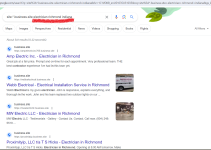In today's digital landscape, having a website is no longer a luxury, it's a necessity. But when it comes to building your business website, there are various options available, each with its own set of advantages and disadvantages. While drag-and-drop website builders like Wix, Squarespace, and Weebly offer a seemingly easy and affordable solution, they might not be the best choice for your business website in the long run. Here's why:
1. Limitations in Search Engine Optimization (SEO):
One of the primary goals of any business website is to be visible in search engine results pages (SERPs). This is where SEO comes in, helping your website rank higher for relevant keywords, attracting organic traffic, and ultimately, potential customers. However, drag-and-drop builders often have limitations in terms of SEO customization.
- Template-driven code: These platforms rely heavily on pre-built templates, which often limit the level of control you have over the underlying code. This code might not be optimized for search engines, hindering your website's ability to rank for relevant searches. For instance, the code might not be structured in a way that search engine crawlers can easily understand and index your website content.
- Limited control over meta descriptions and title tags: These crucial SEO elements provide search engines and users with information about your website content. While some drag-and-drop builders offer basic control over these elements, it might not be enough for effective SEO optimization. You might be restricted in character count, hindering your ability to create compelling and informative descriptions that entice users to click on your website in search results.
- Difficulty building backlinks: Backlinks are links from other websites to yours, acting as votes of confidence in the eyes of search engines. Building backlinks can be challenging with drag-and-drop builders, as you have limited control over the website structure and content. The platform's limitations might make it difficult for other websites to link to you naturally, hindering your website's authority and search engine ranking.
2. Lack of Ownership and Control:
While drag-and-drop builders offer a convenient way to build a website, it's important to remember that you don't truly “own” your website in the same way you would with a custom-built website.
- Platform dependence: Your website is essentially built within the framework of the chosen platform. This can limit your control over various aspects, such as functionality, design, and security. If you ever decide to switch to a different platform or hosting provider, migrating your website can be difficult, if not impossible. This can be a major drawback if you decide to move your business elsewhere in the future, potentially forcing you to rebuild your online presence from scratch.
- Content ownership: While the content you create belongs to you, the platform itself owns the underlying code and infrastructure that your website relies on. This means if you encounter any issues or disagreements with the platform, they have the right to terminate your website and access, potentially leading to the loss of your valuable content and online presence. This lack of control can be a significant risk, jeopardizing your ability to manage and maintain your online presence as you see fit.
3. Homogenization and Lack of Uniqueness:
Drag-and-drop builders rely heavily on pre-designed templates to help users build their websites. While this can be helpful for beginners, it can also lead to a lack of uniqueness and individuality, potentially hindering your ability to stand out from the competition.
- Templated layouts: These platforms offer a limited number of pre-designed layouts and elements. This can result in your website looking similar to countless other websites built using the same platform, hindering your ability to establish a unique brand identity and differentiate yourself from competitors.
- Limited customization options: Even within the chosen template, the level of customization offered by drag-and-drop builders might be limited. This can restrict your ability to tailor the website's design and functionality to perfectly match your specific brand and business needs. You might be unable to achieve the specific design elements or functionalities that are crucial for your brand identity and user experience.
4. Potential Performance Issues and Scalability:
Website speed and performance are crucial factors affecting user experience and SEO ranking. While drag-and-drop builders have improved significantly in recent years, some inherent limitations can still impact your website's performance and scalability:
- Shared resources: Many drag-and-drop builders utilize shared resources to manage multiple websites on the same server. This can potentially lead to slower loading times, especially during peak traffic periods, negatively impacting user experience and potentially increasing bounce rates. Additionally, as your website grows and attracts more traffic, the shared resources might not be sufficient to handle the increased demand, leading to performance issues.
Limited Control over Technical Aspects: Drag-and-drop builders often limit your control over technical aspects of your website, such as server configuration, caching, and security measures. This can make it difficult to optimize your website for peak performance and implement advanced functionalities specific to your business needs.
Hidden Costs: While drag-and-drop builders advertise themselves as affordable solutions, hidden costs can quickly add up. Upgrading storage, bandwidth, or adding essential features often requires additional paid plans. This can negate the initial cost-effectiveness of these platforms, especially as your website grows and requires more resources.
What are the Alternatives?
While drag-and-drop builders might seem like an attractive option, they come with limitations that could hinder your business website's long-term success. Here are some alternative approaches to consider:
- Hiring a Web Designer: While it might involve a higher initial investment, working with a professional web designer offers several advantages. They can create a custom website tailored to your specific needs, brand identity, and growth goals. Additionally, they can optimize your website for SEO and ensure a high level of performance and scalability.
- Open-Source Content Management Systems (CMS): Platforms like WordPress offer greater control and flexibility compared to drag-and-drop builders. While requiring some technical knowledge to set up and manage, they provide greater customization options, SEO optimization capabilities, and a wider range of plugins and extensions to enhance your website's functionality.
- Hybrid Approach: You can combine elements of different approaches. For example, you could use a drag-and-drop builder for a simple landing page while employing a web developer to build your main website with custom functionalities.
When it comes to your business website, shortcuts may lead to long-term challenges. Avoid the pitfalls of using drag-and-drop builders like Wix and Squarespace. Instead, invest in a professional web design service that prioritizes your unique identity, SEO, and long-term ownership of your digital assets. For assistance, contact Instant Web Tools at 513-802-4668 or email dennis@instantwebtools.com. Subscribe to dennis.tips for ongoing insights into optimizing your web presence and business success.





